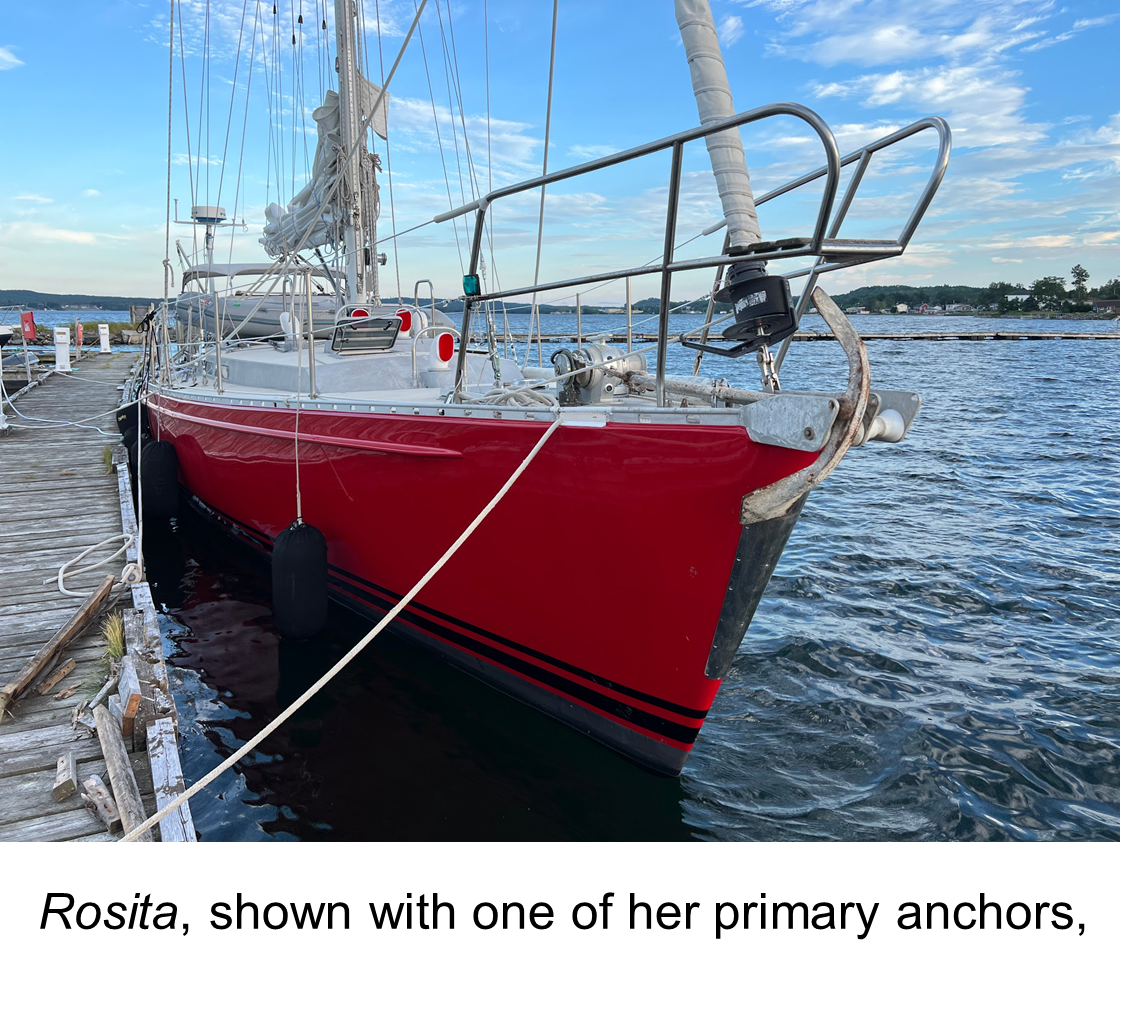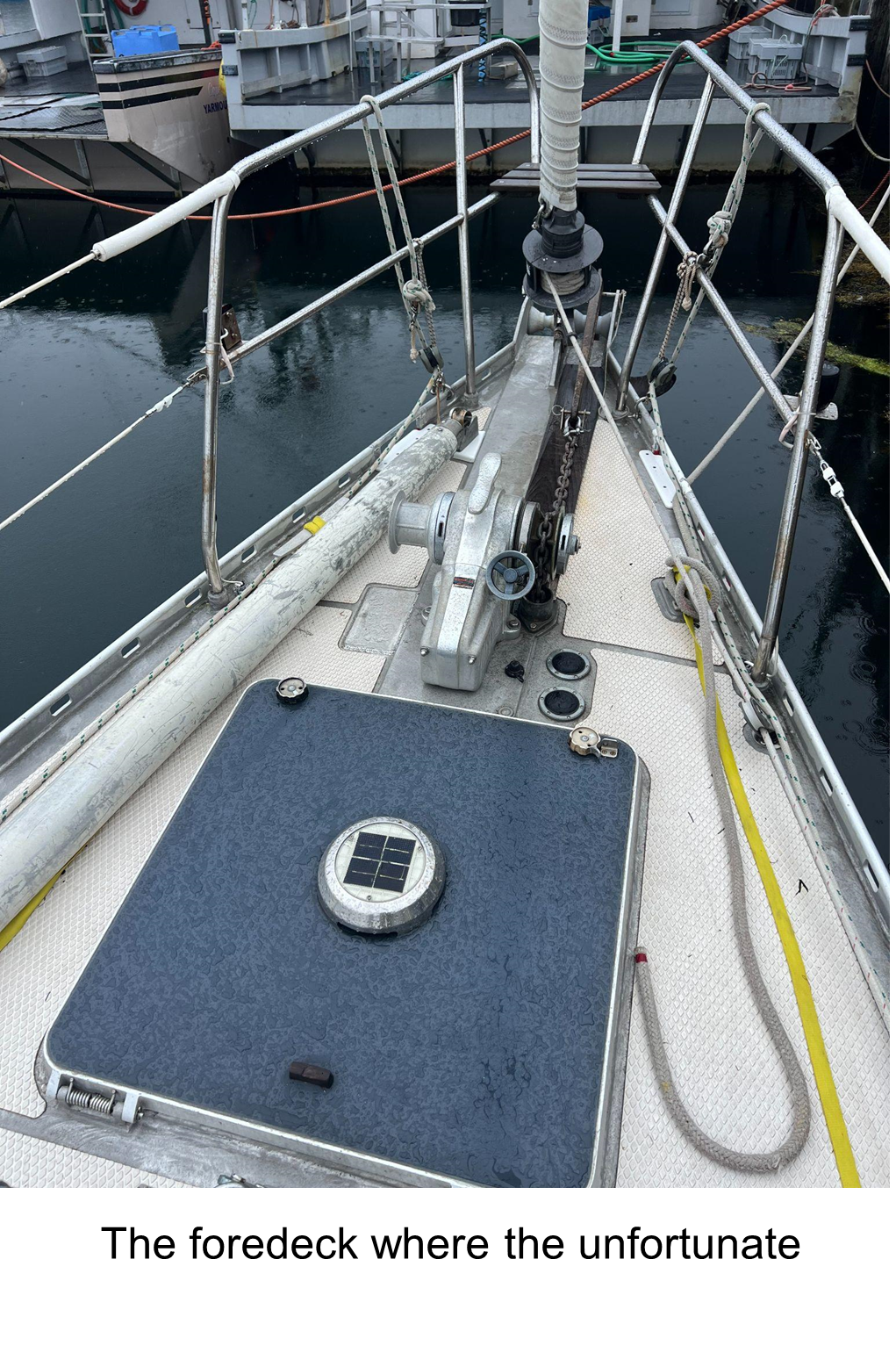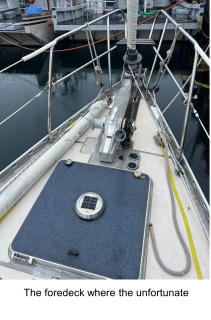Undone by Unappreciated Risk in Routine Maneuver
Undone by Unappreciated Risk in Routine Maneuver
“From the CCA School of Hard Rocks
...lessons learned in pursuit of the Art of Seamanship”
By Michael Moore, Boston Station/Buzzards Bay Post, October 2024
After 25 years of owning Rosita, a 55’ Kanter, I learned a hard lesson about how not to change out the main anchor.
July 7th, 2024 - Hannah and I were headed off for another summer on our sailboat in Newfoundland and Labrador. We had just arrived in Squid Hole, Isle aux Morts, Newfoundland, and I was changing the anchor on the chain from a 100lb Bruce to a 100lb Fisherman, as we do for cruising there, given the preponderance of a rocky bottom. The Fisherman is stowed in the forepeak, which is accessed through a 3’ square deck hatch just behind the anchor winch. We use a masthead halyard led back to a cockpit winch operated by a second person to haul anchors in and out of the forepeak locker.

To change anchors, the Bruce is disconnected from the anchor chain, and with the halyard led over the bow pulpit and attached to the anchor via its shackling point. A tag line leads back to the windlass capstan, the anchor is fed over the bow roller. It is then hoisted while being held away from the pulpit, then over the lifeline, and lowered onto the deck. The Fisherman is then hoisted out of the forepeak, and placed over the bows, using the same maneuver in reverse. A tag line to the anchor ring is led back to the anchor winch capstan. The tag line is then hauled in as the halyard is slacked off, pulling the shank of the fisherman into the bow chock. The tag line has three wraps around the capstan head which is controlled by deck switches located to starboard of the midline. The halyard is slacked off once there is load on the tag line. The tag line is then winched in to seat the anchor on the bow roller before attaching the chain. I have done this many times over the 25 years that we have owned the boat.
What went wrong: I had not closed the deck hatch, as after the fisherman was in place, the Bruce would need to be stowed. Thus, to operate the winch I was kneeling on the starboard side of the bow deck facing aft. With my left hand I was controlling the winch control switch, and with my right hand I was tailing the tag line as it fed off the front of the capstan barrel, as the anchor was moving aft into the stowed position. My right thumb strayed between the line feeding onto the capstan while I tailed the line, while operating the switch to haul the anchor aft. Not looking at where my right hand was, as I was checking on the progress of the anchor. My right thumb complained loudly, as it was crushed between the line and the winch drum, and my left hand kindly reversed the direction of the capstan, but my right thumb looked like an overripe banana by then. Had I been kneeling on the closed deck hatch, I would have been tailing the tag line in my left hand, opposite from the loaded side of the capstan, I would have had my hands and the anchor all in view, and my right hand would have been on the switches.
Why it went wrong:
- We had just completed a 13-hour day passage from Ingonish NS. I was tired, despite alternating watches with Hannah and getting some sleep.
I had never thought through the need during that operation, to always close the hatch unless it needed to be open at that moment. If the hatch had been closed, I would have been kneeling on it, facing forward, operating the switch with my right hand and tending the tag line as it came off the winch opposite to, instead of parallel to, the loaded line.

We had to anchor before we could sleep. But had I thought through the orientation of my body relative to the winch it would have been obvious that the hatch had to be closed so that I could kneel on it, and tail the line as one does, downstream of the line under load, not kneeling over it upstream of the load like the damn fool I was being. It took me 25 years to come to that conclusion. I have a Tasmanian cousin who has a saying that on every farm, there is a tractor waiting to kill you. On every boat there is some maneuver that we do regularly that is waiting to damage us, at least. Happily, no bone or tendon was majorly affected. Eleven stitches for two degloved lacerations, one dorsal, the other palmar. Three weeks of antibiotics, lots of hygiene, a very swollen thumb that gave the sutures trouble and hence some scarring, a splint to stop me using it, and a rubber glove to keep it dry when necessary, and it has done quite well. Also, we were close to a dock with road access and a cab to the hospital in Port aux Basques. A day later we would have been 50 miles from the nearest road.
A month of operating a sailboat one handed with one other person, i.e. a total of three functional hands is quite limiting. We spent a week tied to the dock in Isle aux Morts reading and hiking, and then retreated to the Bras d’Or for two more weeks of hiking and binge reading, before gently exploring the coast of Nova Scotia southeastwards. Happy to be alive and fully thumbed.
The Cruising Club of America is a collection of passionate, seriously accomplished, ocean sailors making adventurous use of the seas. All members have extensive offshore boat handling, seamanship, and command experience honed over many years. “School of Hard Rocks” reports, published by the CCA Safety and Seamanship Committee, are intended to advance seamanship and help skippers promote a Culture of Safety aboard their vessels.






